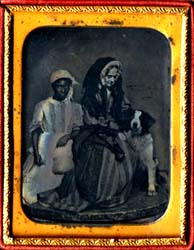
|
Although we cannot know if the young Black woman in this photograph is free or enslaved, one thing that is remarkable about this image is how she stares so directly at us, while the elderly woman is paying attention only to the dog ― who, by the way, is also looking into the camera. Photographs such as this were expensive: it is a large format and the elderly woman wears proper but clearly costly and fashionable clothes. So, the woman at the center probably commissioned it because both the young servant woman and the dog were important to her, part of her private, household life, and part of what she saw as her own identity as a mistress and a caretaker.
And yet, she is not the one making contact so boldly with us through the camera’s lens. So, who truly commands the presence of this portrait? What does a photograph such as this tell about the relationship of employer ― or master, or mistress ― to servant? What were, and what still are, the social meanings of race that would explain the dynamics between the women here and how they feel comfortable presenting themselves to the camera? |

